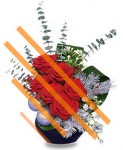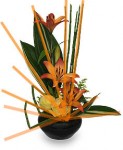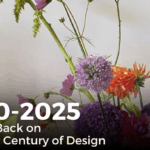The Elements of Design are a universal concept shared between designers everywhere. Whether you are a floral designer, furniture designer, graphic designer, or even something as crazy as a cheese sculpture designer, to be good, we all use the same, basic building blocks.
A good designer learns every aspect of his trade and uses the elements, along with the principles of design, to give their works an added little “oomph.” Anyone can put flowers in a vase, but only the most talented florists can tantalize your senses with their expertly crafted designs.
Using the right lines is important to convey your intended moods and emotions in your arrangements. Using line correctly, in conjunction with the other elements of design, can give your arrangement an overall finished, top-quality look.
Line [lahyn] Show-noun/laɪn/
- A visual path that directs eye movement through composition.
- Something arranged along a line, esp. a straight line; a row or series: a line of trees.
- A band of color, a seam, or a furrow: lines of stratification in rock.
- The edge of a shape.
We all know what a line is, right? Sure, a line is a visual path between point A and point B, but that is just the start of it!
TYPES OF LINE
Actual Lines are lines that are actually physically present. We may not think about it, but everything we use in our arrangements have line qualities in them. Leaves edges (curved, or straight) create line. Bands of color — such as a row of red roses amongst white ones creates line. Keep track of these little features in all your arrangements and you will train your eye to instantly see them.
-
IMPLIED LINE
Implied Lines are lines that are created by your mind’s eye. Your choice of composition makes it appear as though they were there. A connection of two similar visual elements, the continuation of a repeated element in the arrangement — there are many many ways to use implied lines.
-
STATIC LINE
A static line can be either vertical ( | ) or horizontal ( — ) and are at rest. These lines are not falling, leaning, or showing any potential for movement, so visually gives you the impression of rest. These static lines can give stability to an otherwise chaotic design.
Horizontal lines – calm, quiet, rest. (Frank Lloyd Wright architecture)
Vertical lines – more potential fore movement, reflect power and spirituality. (Think corporate buildings and cathedrals.)
If you have a design you think is too dynamic, try adding a static line of some form to balance the look.
-
DYNAMIC LINE
A dynamic line as a line that is not horizontal or vertical. This can be curved, zigzagged, slanted, diagonal; basically anything that is not static. Dynamic lines infuse the idea of movement into your flower arrangement because these lines are not at rest.
There are different degrees of dynamic lines in floral design as well. The softly curved edge of an Aspidistra leaf definitely gives you a different impression than a tangle of curly willow.
 PROPERTIES OF LINE
PROPERTIES OF LINE
- Vertical + Horizontal
When you combine vertical lines with horizontal lines you create a geometrically inspired structure. Because they are both static lines, this type of arrangement reflects strength, reliability, and safety. (Great for Fathers Day designs!)
- Curved Lines
Curved lines are those that gently relax into an arched shape. These are gentle, comforting lines. The human body is made up of curves, thus these lines are familiar, pleasing, and reflect relaxation and sensuality.
- Strong Lines
Strong lines are those that are bold and in your face such as bamboo or Equisetum. These must be positioned carefully and very purposefully and give your arrangement a crisp, tight look.
- Imperfect Lines
These are the types of lines that are rough, and jagged to create texture. These usually not used for the focal point in line designs.
How do you use line in your floral designs?


 Find Your
Find Your 








SO far, so goo, kido! It\’s good to see this sort of thing put out for all florists to see!
As Mandy stated, the elements & principles are the same no matter what the medium. In fact this has become one of the “trick questions” i use when interviewing untrained potential employees…..”what are your hobbies?” I’ve learned that if someone paints, sculpts, quilts or does any of the hands-on arts they will be good at floral design. All I have to teach them are the basic mechanics. They already know about line, depth, focal, balance and color harmony.